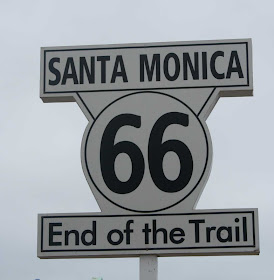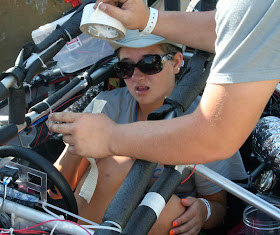Mr. Smith consults with Jim, our judge for the last leg of the race, about the race route.
The canopy was propped up facing east until it was time to depart.
While we were waiting for the race to start, I took a walk through the community park. Under a stand of pine trees I found a big pine cone. One of the park employees told me that the pine trees are stone pine. They are not native to the area but a common tree used by landscapers. They originate from North Africa and the Mediterranean area.
The park has a grove of siberian elm. I was told that the park contains one of the highest concentrations of siberian elm in California and that they are forty years old. In the photo below you can see that they produce broad shade.
Here are two washingtonia palm trees.
Group shot left to right: Jim our judge, Tyler, Nick, Brittany, Myles, Joe, and Chris
If you are interested in watching a few of the cars depart on their last leg of the race, there is a video below.
Because we only drove a short while before trailering the car (had to be in LA at the very latest 1:00), I was unable to take photos of the landscape. The route took us from the high desert to the low desert and through the Yucca Valley region. When we neared the LA area we saw dozens of wind turbines. The photos do not capture it, but they were quite beautiful— elegant, slender and white against rough brown rock.
We drove first to the Citrus Community College in Glendora, California. Here we found a few fast food restaurants for lunch and then departed for a drive past Los Angeles City Hall and the end of the race at the Los Angeles Coliseum. The weather was in the low 70's and the breeze was refreshing. It was a comfort to be out of the dry desert heat.
Myles ready to drive the 26 miles to the center of Los Angeles
Because we were driving through LA traffic, the order of our caravan was changed. Mr. Harris was to ride in front of the solar car so that if needed, the car could easily be pushed up into the trailer. I was to drive behind the solar car with the judge. My job was to protect the solar car from other cars. Looking at the route we were taking made me quite nervous because we had many stop lights to go through. Myles did a great job of being the eyes for both of us. If he did not think the light would be long enough for both of us to safely make it through, he stopped. Often Mr. Smith and Mr. Harris would have to slowly inch their way forward waiting for us when we were stopped at a light. I asked the judge to take a video of the car being driven.
When we were stopped at a light, people would take pictures and videos. The man on the park bench had a conversation with Myles.
As we approached city hall, our judge was told that we had to drive around awhile and kill 15 -20 minutes. Evidently the cars were backed up near city hall. We found a place to pull over until the congestion eased.
Dr. Cassel and Ms. Smith were at city hall to greet us. It was nice to see familiar faces.
At city hall we were allowed to briefly gather around the car to be photographed. Thank you, Ms. Smith for taking a video of us as we arrived at city hall.
This following photo is lifted off the solar car challenge website http://www.solarcarchallenge.org/challenge/photos.shtml . When each team arrived at city hall, the solar car was ushered curbside and the other cars circled the block. By the time they returned there was available parking and the teams lined up in front of their cars for a photograph to be taken.
We then continued driving to the Los Angeles Coliseum which was the end of the race. The cars were parked and on display to the public.
Into the setting sun went the Volt-Tech team; they were escorting the car onto its final trailer ride to Ulster BOCES Career and Tech Center.
In the evening a rewards banquet was held. It was nice to not have to eat fast food.
Myles sat at the head table with the other team captains. You can see in the slide show above him a photo of our team.
A local high school's jazz trio played for us.
Each team captain made an impromptu speech.
Dr. Rani Wesson, an American Astronautics Systems Engineer focusing on planetary exploration, an employee of the California Institute of Technology Jet Propulsion Laboratory, and a Senior Technical staff member of NASA, made a fascinating presentation on what NASA has done and is planning on doing in the future. He briefly highlighted our solar system in succession. For example, he mentioned that Europa, one of Jupiter's moons, has a frozen surface. Scientists believe that under its surface is frozen water. NASA wants to penetrate the ice and explore the water below.
Team captain, Myles Harris, on behalf of the Volt-Tech team, accepts the trophy for the winner of the advanced division. Congratulations to all the Ulster BOCES students who were involved in making the solar car challenge a reality!
Team Volt-Tech was presented with three trophies: winner of the advanced division, winner for most miles covered during the last leg of the race, and overall winner of the highest level of technical achievement. Well done everyone!
The next day we had a couple of free hours before having to leave for home. We stopped at the Santa Monica pier.
Here is where you can get your kicks.
LA International is a great example of Googie architecture. Many buildings look like sets for the Jetsons. Thankfully, our flight was uneventful. Thank you to Rhoda for picking us up in Newark and returning us safely to Ulster BOCES.
The completion of the solar car race will be memorable to all the many students from around the country who were involved. Friendships were made, and troubleshooting and team work became the norm. I am certain that many students will be inspired to set high goals.
For me it was a pleasure to be a part of the solar car challenge. Although driving through desert landscapes at 20 mph and seeing beauty around me was soothing, serenity emerged more subtly than through the senses. It happened unnoticed when the shell of adulthood was broken by the simplicity of youth. Adults are preoccupied with the past and the future; the present is unnoticed. The dozens of youth that I encountered daily focused only on their immediate task, whether that be maintaining at least 15 mph up an incline, analyzing voltage use, soldering, contemplating menu choices, or finding another pair of clean socks. They did not worry about how much time they might have when returning home to paint a bedroom, or what to remember not to forget, or whether obligations could be met. They only focused on the moment. In between the moment at hand were smaller moments of naps, laughter, or music from earbuds. Being on the fringe of that mindset allowed my fifty one year old self an escape. I was shocked to discover that I was seriously defending my position that a silverback gorilla could defeat a klondike bear. During occasions such as that, I too was focusing only on the moment. It was a privilege to be allowed these brief moments of relapse into youth.













































































